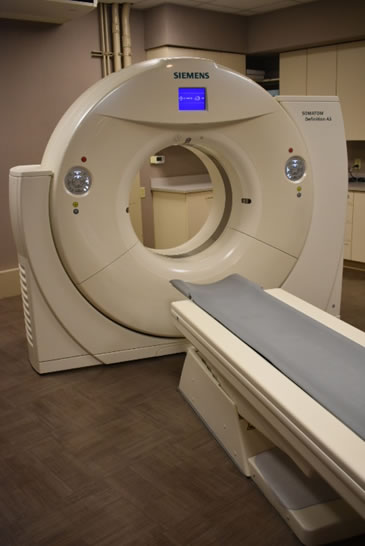CT SCAN OR COMPUTED TOMOGRAPHY
 What is a CT Scan?
What is a CT Scan?
A computed tomography (CT or CAT) scan is a medical imaging procedure that allows doctors to see the inside structures of a patient's body. A CT is more detailed than an X-ray and produces cross sectional imaging or a slice of one's body by using a narrow x-ray beam that rotates around the body. It can be compared to looking at one slice of bread within a whole loaf. Not only can these images be 2D, but the information can be reconstructed into 3D images. All of this information is helpful in diagnosing and treatment of injuries and disease.
How are CT Scans done?
A registered radiologic technologist will perform the CT scan. During the test, you will lie on a table inside a large, doughnut-shaped CT machine. As the table slowly moves through the scanner, the X-ray tube rotates around your body collecting information as the X-Rays pass through your body. Any motion you make can blur the image, so you will be asked to stay very still and may be asked to hold your breath.
A CT scan may require the use of oral or IV contrast, which is used to enhance the visibility of internal structures. Most CT scans last less than a few minutes, and often it takes more time to prepare for the scan than it does to do the imaging.
What is it used for?
- CT scans can help detect bone and joint problems, such as bone fractures and tumors.
- CT scans are used to help diagnose acute symptoms like difficulty breathing or abdomen pain and are useful in evaluating injuries from trauma such as injury from a car accident.
- If you have a condition like cancer, heart disease, emphysema, or a mass, a CT scan can help detect it or help doctors see any changes in your condition. CT scans are often the best method for detecting cancers in the chest, abdomen and pelvis.
- After detection, doctors use CT scans to guide treatment plans and procedures, such as biopsies, surgeries, and radiation therapy treatment planning.
- Doctors can compare CT scans to find out if certain treatments are working. For example, scans of a tumor over time can show whether it is responding to chemotherapy or radiation.
- Doctors can also use CT scans as a screening tool to detect lung cancer in patients who have a smoking history and are high risk.